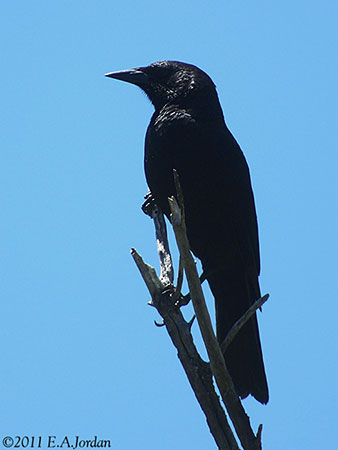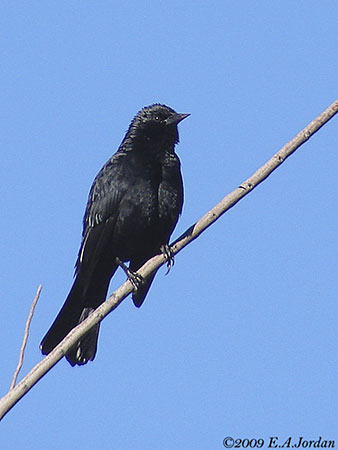
Fr: Carouge austral
Ang: Austral Blackbird
All: Strichelkopfstärling
Esp: Tordo Patagón - Tordo patagónico - Tordo
Ita: Ittero australe
Nd: Stekelkoptroepiaal
Sd: sydtrupial
Photographers:
John Anderson
John Anderson Photo Galleries
Eduardo Andrés Jordan
MIS AVES – AVES DE ARGENTINA
Text by Nicole Bouglouan
Sources:
HANDBOOK OF THE BIRDS OF THE WORLD Vol 16 by Josep del Hoyo- Andrew Elliot-David Christie – Lynx Edicions – ISBN: 9788496553781
BIRDS OF SOUTH AMERICA – Passerines - by Robert S. Ridgely and Guy Tudor – HELM Field Guides – ISBN: 9781408113424
NEW WORLD BLACKBIRDS – THE ICTERIDS by Alvaro Jaramillo and Peter Burke – Helm - ISBN: 0713643331
Arthur Grosset's Birds (Arthur Grosset)
Sistema de Información de Biodiversidad de la Administración de Parques Nacionales, Argentina
Red de Observadores de Aves - Tordo
Wikipedia, la enciclopedia libre
Austral Blackbird
Curaeus curaeus
Passeriformes Order – Icteridae Family
INTRODUCTION:
The Austral Blackbird is found in SW Argentina and C Chile, but it also occurs S to Tierra del Fuego where it is not as abundant as it is on the mainland.
It frequents temperate forests, mountains, hills and ravines, but it can be seen in cultivated fields and occasionally in urban areas. It feeds on insects and various invertebrates including aquatic species, seeds, fruits and nectar from Bromeliad Puya.
The Austral Blackbird is monogamous and solitary nester. The nest is a large cup placed in thick shrub or tree, rather close to the ground. Helpers are probably present and help to feed the young birds.
The Austral Blackbird is common and widespread in most of the range, except in Tierra del Fuego. The species is not globally threatened at the moment.

DESCRIPTION OF THE BIRD:
Biometrics: depending on the subspecies
Race Curaeus curaeus curaeus
Length: 28 cm – Weight: M: 83-3 g – F: 90 g
Race Curaeus curaeus reynoldsi
Length: 31 cm – Weight: M: 114,5 g – F: 99 g
Race Curaeus curaeus recurvirostris
Length: 25-30 cm
The Austral Blackbird of nominate race has entirely black plumage with a dull blue gloss. The feathers of head, nape, neck and throat are pointed and can be conspicuously raised.
The long, black bill is pointed, noticeably flattened on culmen ridge. The eyes are dark brown. Legs and feet are black.
The female resembles male, but with duller gloss on body plumage. The belly is brownish-black and lacks iridescence.
The immature is similar to adults but the pointed feathers are less pointed and this area is reduced. On the upperwing, primaries and secondaries are brownish, contrasting with the black tertials, coverts and body.
The juvenile has dull plumage overall, mainly brownish-black and lacking iridescence. The belly is brown. Tail and wings are brownish. No pointed feathers.
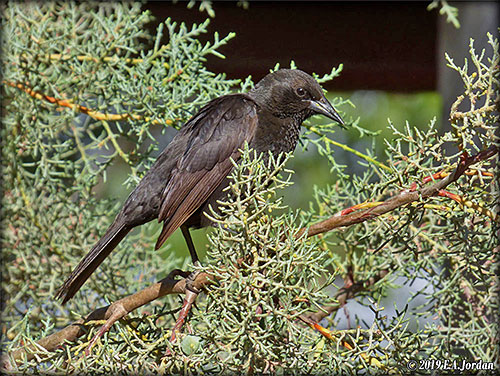
SUBSPECIES AND RANGE:
The Austral Blackbird has three subspecies.
Curaeus curaeus curaeus (described above) is found in C and S Chile, S including Chiloe Island and several islands along the coast. It occurs S to Straits of Magellan, and SW Argentina.
Curaeus curaeus recurvirostris is found only on Isla Riesco in S Chile (Magallanes).
This race is slightly larger than nominate, especially both wings and bill size. The bill is reported to be slightly recurved at tip, but this feature requires further study. This distinctive shape could be an adaptation to local food resources.
Curaeus curaeus reynoldsi occurs in S Chile and extreme S Argentina, in Tierra del Fuego and nearby islands.
This race is larger than nominate, with narrower bill.
HABITAT:
The Austral Blackbird in C Chile is usually found at the edges or in clearings of deciduous Nothofagus woodlands, and in more open areas with nearby trees and shrubs. It also frequents sea beaches and lake shores, pastures, Pinus plantations and cultivated fields.
In Argentina, it is mainly in Nothofagus woodlands and their borders.
In the norther part of Tierra del Fuego, it frequents mainly humid steppes.
The species is visible from sea-level up to 1,500 metres of elevation.
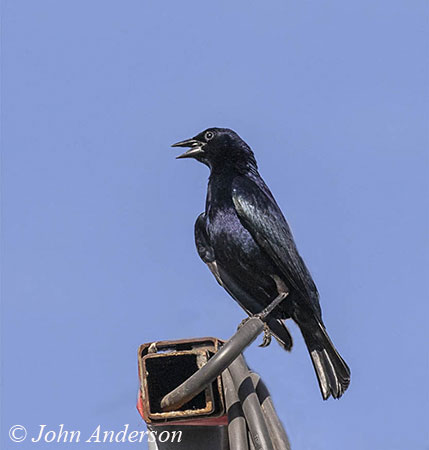
CALLS AND SONGS: SOUNDS BY XENO-CANTO
The Austral Blackbird is a rather vocal Icteridae with a varied repertoire.
The call is a three syllable nasal sound, but not harsh, described as “ku-ra-taaooow” or only the two first syllables “krru-taaooow”. This call is given in most circumstances, including in flight.
The slow song is pleasant and musical, with a short pause between the phrases. It consists of squeaks, trills and whistles, mixed with the typical “ku-ra-taaooow” call. We can also hear piercing whistles and stuttering trills. Single whistles and chucks have hollow or ringing sound, whereas trills and chatters are often followed by a sharp “cheep” note or a whistle.
Two or three birds may sometimes sing together, perched on the highest tree branches.
Near the roosting sites, the flocks are vocal but they only sing sweet melodies.
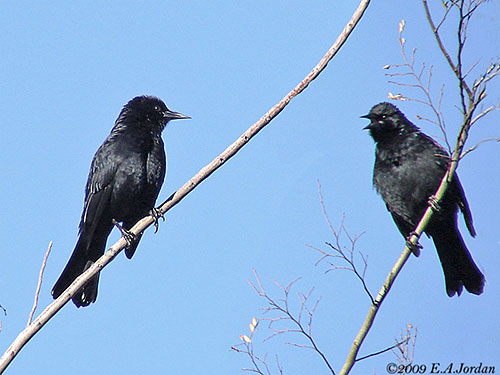
BEHAVIOUR IN THE WILD:
The Austral Blackbird is opportunist and omnivorous. The diet includes beetles, pollen larvae, small rodents, passerine’s eggs and chicks, seeds and fruits from both native and introduced plant species. Nectar from Bromeliad Puya and Eucalyptus is also consumed. It also feeds sometimes on wheat and corn, causing some economic damages.
The Austral Blackbird forages both on the ground and on vegetation, searching for insects in large tree trunks, often in Nothofagus forests, usually near the canopy. In more open areas, it probes in buds and gleans from foliage in dense shrubbery. On the forest floor, it forages in moist sites. When in cultivated fields, it forages near the edges, close to the tall vegetation.
The Austral Blackbird sometimes feeds in flocks. An individual remains perched on high exposed branch to keep an eye on the surroundings. When a predator or an intruder approaches, it gives an alarm call to warn the feeding flock.
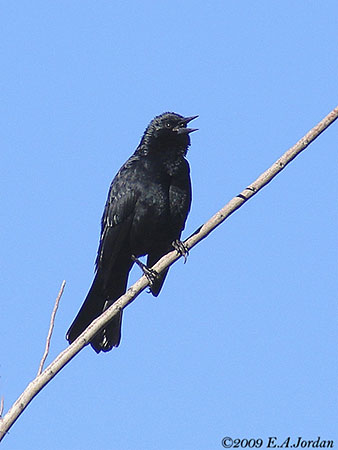
The courtship displays of the Austral Blackbird are unknown, but we can suggest that the pointed feathers of head, nape, neck and throat are raised while the male is singing. Some flight displays probably occur too.
The nest is a large cup placed in thick foliage in shrub or tree. Both adults, and possibly some helpers, share the nesting duties, especially feeding the juveniles.
The flight of the Austral Blackbird is direct with rapid wingbeats.
REPRODUCTION OF THIS SPECIES:
The breeding season takes place from October to December. The species is monogamous and solitary nester. Co-operative breeding possibly occurs.
The Austral Blackbird builds a large, cup-shaped nest with sticks and coarse grass, often reinforced with mud. It is placed in thick vegetation, low trees or shrubs with dense foliage. The nest is often less than two metres from the ground, usually between 1,5 and 3 metres.
The female lays 3-6 pale blue eggs with dark spots and streaks at the broader end. The duration of both incubation and fledgling periods is unknown. The female has a brood patch and probably incubates alone.
“Nest-helping” may occur. Some observations report at least six individuals observed to feed the chicks at one nest on Victoria Island. Fledglings were also fed by several group members.
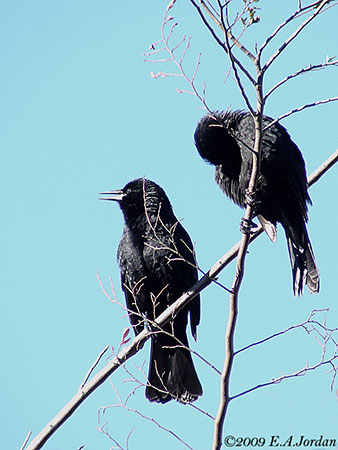
PROTECTION / THREATS / STATUS:
The Austral Blackbird is common and widespread in most of the range, although the species is less common in Tierra del Fuego.
It is able to adapt to moderate changes in its natural habitats. It is present in several protected areas, including National Parks in Chile and S Argentina.
The size of the population is unknown, but it is suspected to be stable.
The Austral Blackbird is currently evaluated as Least Concern.
